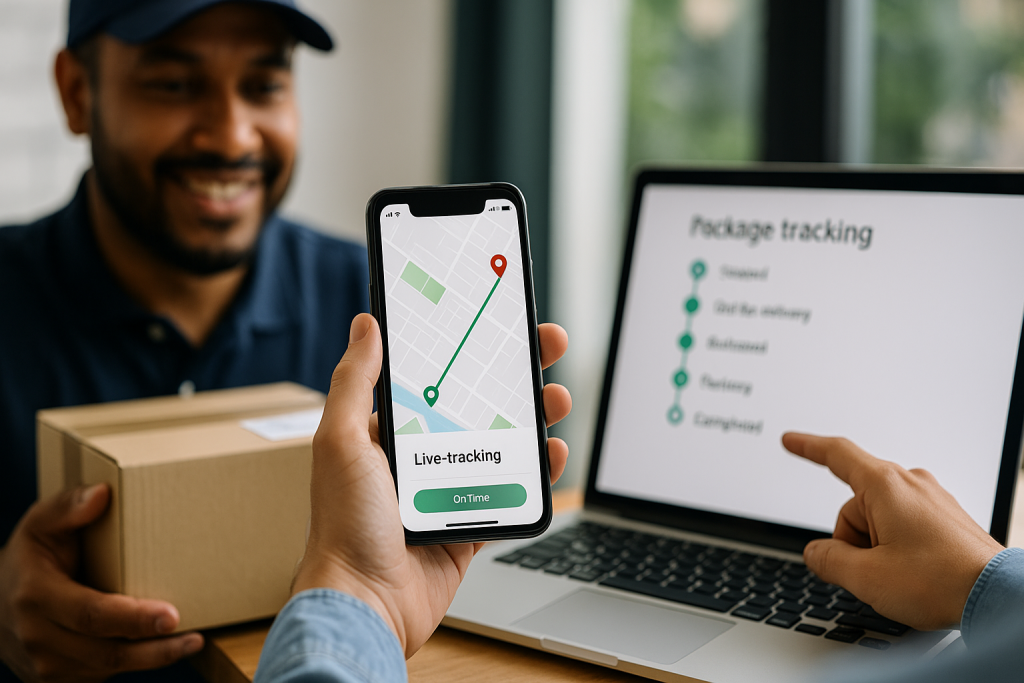By Martin Vassilev / 10 Oct, 2025
In today’s fast-paced logistics and e-commerce landscape, real-time tracking has become a cornerstone of modern delivery operations, redefining how businesses communicate with their customers and partners. The ability to track shipments, inventory, and fleet movement in real time builds a level of operational transparency and trust that was once impossible to achieve with legacy systems.
From improving delivery accuracy to enhancing customer satisfaction and driving supply chain efficiency, real-time tracking provides measurable advantages for both businesses and consumers. This comprehensive guide explores how real-time tracking boosts transparency, builds customer confidence, and helps brands stay ahead in an increasingly competitive market.
Real-time tracking refers to the continuous monitoring of shipments, vehicles, and inventory through GPS, RFID, IoT sensors, and cloud-based platforms. Unlike traditional periodic updates, real-time systems deliver up-to-the-minute location and status information, enabling businesses to provide accurate ETAs and resolve issues proactively.
For example, platforms that integrate IoT sensors with fleet telematics can automatically relay updates as shipments move through various nodes. This technology is not limited to international shipping — even local fulfillment networks use real-time tracking to optimize delivery routes, cut costs, and boost service reliability.
If you’re interested in how this fits within broader logistics systems, explore how AI is transforming the logistics industry in 2025, where advanced analytics are reshaping tracking and visibility.
One of the biggest challenges in logistics has always been the “black box” period between dispatch and delivery. Businesses often lose visibility once goods leave the warehouse, creating uncertainty for both internal teams and customers. Real-time tracking eliminates these blind spots by providing complete visibility from origin to destination, enabling logistics managers to:
Identify delays immediately and reroute shipments if necessary.
Monitor driver behavior to ensure compliance and efficiency.
Track temperature or humidity for sensitive goods through sensor data.
Generate automated alerts when shipments deviate from planned routes.
This transparency is essential for complex networks like cross-border shipping, where multiple carriers, customs procedures, and time zones are involved. Companies that master visibility can reduce exceptions, lower operational costs, and build customer loyalty.
Modern customers expect fast, transparent, and reliable delivery updates. Real-time tracking enables businesses to share precise ETAs, trackable links, and proactive notifications that reduce anxiety and increase confidence in the brand.
When customers can see the exact location of their packages and receive automatic updates, trust naturally grows. This is especially critical for e-commerce brands, where delivery experience plays a major role in repeat purchases and online reviews.
For example, many businesses now integrate real-time updates directly into their customer service portals, reducing the need for “Where is my order?” inquiries and lowering support costs. To see how this fits into overall fulfillment excellence, refer to the ultimate guide to fast fulfillment.
Delays happen — weather disruptions, customs holdups, or mechanical issues can cause unavoidable setbacks. Real-time tracking allows companies to communicate these delays proactively rather than leaving customers in the dark.
Proactive notifications with updated ETAs and explanations signal professionalism and respect for the customer’s time. This level of openness helps preserve trust, even in the face of unexpected challenges. In fact, studies from the U.S. Department of Transportation highlight how transparent communication during logistics disruptions significantly improves customer satisfaction scores.
Real-time tracking doesn’t only benefit customers — it also has a profound impact on internal operational efficiency. By capturing live data from trucks, warehouses, and routes, companies can make informed decisions on:
Route optimization to reduce fuel and time costs.
Dynamic resource allocation, such as redistributing fleet vehicles based on current demand.
Inventory synchronization, ensuring warehouse stock levels align with in-transit goods.
Carrier performance monitoring, enabling faster issue resolution.
Integrating real-time tracking data with warehouse systems further improves throughput. Many businesses adopt solutions similar to those discussed in the future of warehouse automation, where real-time data powers robotics and automated picking systems for faster order processing.
In addition to improving transparency, real-time tracking is increasingly becoming a compliance necessity. Government agencies in Canada, the U.S., and the EU are tightening fleet monitoring and reporting regulations.
For example, Electronic Logging Device (ELD) mandates require transport companies to record driver hours automatically, ensuring legal compliance and safety. Real-time GPS data provides regulators with auditable trails, protecting businesses against disputes and potential penalties.
Official resources such as the Government of Canada’s Transport Safety Regulations provide detailed frameworks for businesses integrating telematics into their logistics operations.
Real-time tracking is the bridge between fulfillment centers and customers, ensuring that the promises made during checkout are kept during delivery. By combining real-time visibility with intelligent fulfillment strategies, companies can offer services like:
Same-day or next-day delivery, with live status updates.
Dynamic rerouting to reduce failed delivery attempts.
Smart locker or pickup point coordination for flexible customer options.
For example, businesses that rely on strategic logistics hubs, like those between Calgary and Dallas, leverage real-time tracking to maintain consistency across long distances and multiple handoffs.
Losses and damages are costly — both financially and reputationally. Real-time tracking reduces these risks by creating an auditable digital footprint for each shipment. When every scan, GPS ping, or temperature reading is recorded, investigating claims becomes straightforward, and accountability increases across the entire logistics chain.

Consider a Canadian e-commerce retailer shipping thousands of orders nationwide. Before adopting real-time tracking, their customer service team spent hours daily responding to delivery inquiries. After implementing real-time tracking:
Customer inquiries dropped by 40%.
On-time delivery performance improved by 23% due to better route management.
Customer satisfaction ratings surged, with a noticeable increase in repeat purchases.
These results align with industry trends showing that brands offering precise delivery visibility enjoy higher retention and stronger online reputations.
Select a tracking platform that integrates easily with your existing warehouse management and CRM systems. Scalability is crucial to handle growth and seasonal spikes.
A tracking system is only as good as the quality and frequency of its data. Use GPS devices, IoT sensors, and automated scanning to eliminate manual errors.
Provide customers with branded tracking portals or SMS notifications that reflect real-time shipment progress. This not only reduces support workload but enhances brand perception.
Integrating predictive analytics allows businesses to anticipate delays and optimize delivery performance further. This is especially powerful when paired with data analytics strategies for inventory management.
Technology alone is not enough. Logistics teams must be trained to respond quickly to alerts, reroute shipments, and communicate updates effectively.
As AI and machine learning mature, real-time tracking will evolve into predictive logistics, where systems anticipate disruptions before they occur. Predictive ETAs, anomaly detection, and automated decision-making will further strengthen transparency and trust, allowing businesses to deliver exceptional service at scale.
This future is already emerging in advanced markets, with AI-driven logistics platforms integrating seamlessly with real-time data streams for unprecedented visibility.
Real-time tracking is no longer optional — it’s a strategic necessity for logistics excellence. By offering real-time visibility, proactive communication, and operational efficiency, businesses can build lasting trust with their customers, streamline internal workflows, and stay ahead of competitors in a data-driven logistics ecosystem.
Whether you’re optimizing existing operations or building a new fulfillment network, investing in real-time tracking technology lays the foundation for transparency, accountability, and long-term brand loyalty.
For tailored logistics solutions and real-time visibility integration, contact ByExpress today.

“Thanks to Byexpress all my shipping and fulfillment costs are in line now”

“All my issues were solved by Byexpress team that I had with pervious 3pl provider.”

“Thank you Byexpress team could not done it without you guys.”

“Their integration and customer service were the key for me”

“Outstanding delivery service! The package was well-packaged, and
the delivery team was professional and courteous”

“Great and knowledgeable team to work with.”

Thanks, guys, for reducing my shipping rates
Ottawa Office
2411 Holly Lane
Ottawa, ON, K1V 7P2
Toronto Office
13-280 West Beaver Creek Road Unit #136
Richmond Hill, ON, L4B 3Z1
Alexandria Office
173 Kenyon Street West
Alexandria, ON, K0C 1A0
Montreal Office
4388 Saint-Denis Street Unit #200
Montreal, QC, H2J 2L1
California Office
155 North Riverview Drive
Anaheim Hills, CA, 92808
Call Us
Toll-Free: 1-866-744-7122
Local : 613-739-3000
Email Us
Multilingual Services










